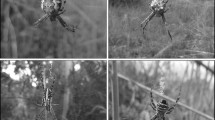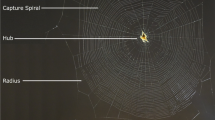Abstract
Theridiidae typically construct a three-dimensional web often described as “irregular.” The web consists of a supporting structure and lines under tension termed gumfooted lines. We used automated methods to observe web construction in the theridiid Steatoda triangulosa under laboratory conditions. Web construction lasted several nights. After orientation, spiders built a three-dimensional structure of several threads radiating sideways and downward from the retreat. To build gumfooted lines, they started from the retreat, moved along a structural thread, then dropped down to attach the thread to the lower substrate. On returning, they coated the lowest part of the thread with viscid silk before moving up along the same thread back to the structural thread. They then continued moving along the same structural thread to drop down again to build the next gumfooted line. This behavior was continued until the spiders had built a series of gumfooted lines (a bout). There were regular intervals between the construction of two bouts. Thus, a single web included many bouts built in different stages. We show that gumfooted lines are not homologues to sticky web elements of orb-weavers and present new synapomorphic characters that support the monophyly of Theridiidae + Nesticidae and the monophyly of araneoid sheet web weavers. Further, the time allocation pattern for different behavioral stages and the fine structure of a gumfooted line are presented.
Similar content being viewed by others
REFERENCES
Benjamin, S. P., and Zschokke, S. (2002a). A computerised method to observe spider web construction behaviour in a semi-natural light environment. In Toft, S., and Scharff, N. (eds.), European Arachnology 2000, Aarhus University Press, Aarhus, pp. 117–122.
Benjamin, S. P., and Zschokke, S. (2002b). Webs of theridiid spiders—Construction, structure and evolution. Biol. J. Linn. Soc. (in press).
Benjamin, S. P., Düggelin, M., and Zschokke, S. (2002). Fine structure of sheet-webs of Linyphia triangularis (Clerck) and Microlinyphia pusilla (Sundevall), with remarks on the presence of viscid silk. Acta Zool. 83: 49–59.
Coddington, J. A. (1986a). The genera of the spider family Theridiosomatidae. Smithson. Contrib. Zool. 496: 1–96.
Coddington, J. A. (1986b). The monophyletic origin of the orb web. In Shear, W. A. (ed.), Spiders—Webs, Behavior, and Evolution, Stanford University Press, Stanford,CA, pp. 319–363.
Coddington, J. A. (1986c). Orb webs in non orb weaving ogre-faced spiders (Araneae: Dinopidae): A question of genealogy. Cladistics 2: 53–67.
Coddington, J. A. (1989). Spinneret silk morphology: Evidence for the monophyly of orbweaving spiders, Cyrtophorinae (Araneidae), and the group Theridiidae plus Nesticidae. J. Arachnol. 17: 71–95.
Coddington, J. A., and Valerio, C. E. (1980). Observations on the web and behavior of Wendilgarda spiders (Araneae: Theridiosomatidae). Psyche 87: 93–105.
Comstock, J. H. (1940). The Spider Book, Comstock, Ithaca, NY.
Eberhard, W. G. (1972). Observations on the biology of Achaearanea tesselata (Araneae: Theridiidae). Psyche 78: 209–212.
Eberhard, W. G. (1975). The 'inverted ladder' orb web of Scoloderus sp. and the intermediate orb of Eustala sp. (Araneae, Araneidae). J. Nat. Hist. 9: 93–106.
Eberhard, W. G. (1977). 'Rectangular orb' webs of Synotaxus (Araneae: Theridiidae). J. Nat. Hist. 11: 501–507.
Eberhard, W. G. (1979). Argyrodes attenuatus (Theridiidae): A web that is not a snare. Psyche 86: 407–413.
Eberhard, W. G. (1981a). Construction behaviour and the distribution of tensions in orb webs. Bull. Br. Arachnol. Soc. 5: 189–204.
Eberhard, W. G. (1981b). The single line web of Phorocidia studo Levi (Araneae: Theridiidae): A prey attractant? J. Arachnol. 9: 229–232.
Eberhard, W. G. (1982). Behavioral characters for the higher classification of orb-weaving spiders. Evolution 36: 1067–1095.
Eberhard, W. G. (1987). Web-construction behavior of anapid, symphyotognathid and mysmenid spiders (Araneae). J. Arachnol. 14: 339–356.
Eberhard, W. G. (1989).Niche expansion in the spider Wendilgarda galapagoensis (Araneae, Theridiosomatidae) on Cocos Island. Rev. Biol. Trop. 37: 163–168.
Eberhard, W. G. (1990a). Early stages of orb construction by Philoponella vicina, Leucauge mariana, and Nephila clavipes (Araneae, Uloboridae and Tetragnathidae), and their phylogenetic implications. J. Arachnol. 18: 205–234.
Eberhard, W. G. (1990b). Function and phylogeny of spider webs. Annu. Rev. Ecol. Syst. 21: 341–372.
Eberhard, W.G. (1992).Web construction by Modisimus sp. (Araneae, Pholcidae). J. Arachnol. 20: 25–34.
Eberhard, W. G. (1995). The web and construction behavior of Synotaxus ecuadoriensis (Araneae, Synotaxidae). J. Arachnol. 23: 25–30.
Eberhard, W. G. (2001). Trolling for water striders: Active searching for prey and the evolution of reduced webs in the spiderWendilgarda sp. (Araneae, Theridiosomatidae). J. Nat. Hist. 35: 229–251.
Forster, R. R., Platnick, N. I., and Coddington, J. A. (1990).Aproposal and review of the spider family synotaxidae (Araneae, Araneoidea), with notes on theridiid interrelationships. Bull. Am. Mus. Nat. Hist. 193: 1–193.
Freisling, J. (1961). Netz und Netzbauinstinkte bei Theridium saxatile Koch. Z.Wiss. Zool. 165: 396–421.
Griswold, C. (1997). Scharffia, a remarkable new genus of spiders from East Africa (Araneae, Cyatholipidae). J. Arachnol. 25: 269–287.
Griswold, C. E., Coddington, J. A., Hormiga, G. and Scharff, N. (1998). Phylogeny of the orb-web construction spiders (Araneae, Orbiculariae: Deinopoidae, Araneoidae). Zool. J. Linn. Soc. 123: 1–99.
Harvey, P. H., and Pagel, M. D. (1991). The Comparative Method in Evolutionary Biology, Oxford University Press, Oxford.
Hopfmann, W. (1935). Bau und Leistung des Spinnapparates einiger Netzspinnen. Jena. Z. Naturw. 70: 65–112.
Hormiga, G. (1994).Arevision and cladistic analysis of the spider family Pimoidae (Aranoidea, Araneae). Smithson. Contrib. Zool. 549: 1–104.
Hormiga, G., Eberhard, W. G., and Coddington, J. A. (1995). Web-construction behaviour in Australian Phonognatha and the phylogeny of nephiline and tetragnathid spiders (Araneae: Tetragnathidae). Aust. J. Zool. 43: 313–364.
Kloeden, C. (1996). Rotater 3.5 for Macintosh, University of Adelaide, Adelaide. Steatoda Web Construction Behavior 809
Kovoor, J., and Lopez, A. (1982). Anatomie et histologie des glandes séricigènes des Cyrtophora (Araneae, Araneidae): Affinites et corrélations avec la structure et la composition de la toile. Rev. Arachnol. 4: 1–21.
Kullmann, E. (1960). Beobachtungen an Theridium tepidariorum C. L. Koch als Mitbewohner von Cyrtophora-Netzen. Deuts. Ent. Z. 7: 146–163.
Lamoral, B. H. (1968). On the nest and web structure of Latrodectus in South Africa, and some observations on body colouration of Latrodectus geometricus (Araneae,Theridiidae). Ann. Natal. Mus. 20: 1–14.
Levi, H. W., and Levi, L. R. (1962). The genera of the spider family Theridiidae. Bull. Mus. Comp. Zool. 127: 1–71.
Marples, B. J. (1955). A new type of web spun by spiders of the genus Ulesanis, with the description of two new species. Proc. Zool. Soc. Lond. 125: 751–760.
McCook, H. C. (1889). American Spiders and their Spinningwork I, Academy of Natural Sciences of Philadelphia, Philadelphia. Nielsen, E. (1932). The Biology of Spiders, Levin and Munksgaard, Copenhagen.
Peters, H. M. (1955). Űber den Spinnapparat von Nephila madagascariensis (Radnetzspinnen; Fam. Argiopidae). Z. Naturforsch. (C) 106: 395–464.
Peters, H. M. (1990). On the structure and glandular origin of bridging lines used by spider for moving to distant places. Acta. Zool. Fenn. 190: 309–314.
Platnick, N. (2002). The World Spiders Catalog, Version 3.0 [online catalog], Merrett P., and Cameron H. D. (eds.), American Museum of Natural History, New York (http://research.amnh.org/entomology/).
Roberts, M. J. (1995). Spiders of Britain and Northern Europe, Collins Field Guide, London.
SAS Institute (1998). Statview, SAS Institute, Cary, NC. Scharff, N., and Coddington, J. A. (1997). A phylogenetic analysis of the orb-weaving spider family Araneidae (Arachnida, Araneae). Zool. J. Linn. Soc. 120: 355- 434.
Sekiguchi, K. (1952). On a new spinning gland found in geometric spiders and its function. Annot. Zool. Jpn. 25: 394–399.
Shear, W. A. (1986). The evolution of web-construction behavior in spiders: A third generation of hypotheses. In Shear, W. A. (ed.), Spiders—Webs, Behavior, and Evolution, Stanford University Press, Standford, CA, M pp. 364–400.
Shinkai, A., and Shinkai, E. (1997). The web structure and the predatory behavior of Wendilgarda sp. (Araneae: Theridiosomatidae). Acta arachnol. 46: 53–60.
Szlep, R. (1965). The web-spinning process and web-structure of Latrodectus tredecimguttatus, L. pallidus and L. revivensis. Proc. Zool. Soc. Lond. 145: 75–89.
Szlep, R. (1966). The web structure of Latrodectus variolus Walckener and L. bishopi Kaston. Israel J. Zool. 15: 89–94.
Vollrath, F. (1988). Untangling the spider's web. Trends Ecol. Evol. 3: 331–335.
Wiehle, H. (1927). Beiträge zurKenntnis des Radentzbaues der Epeiriden, Tetragnathiden und Uloboriden. Z. Morph. Ökol. Tiere 8: 468–537.
Wiehle, H. (1931). Neue Beiträge zur Kenntnis des Fanggewebes der Spinnen aus den Familien Argiopidae, Uloboridae und Theridiidae. Z. Morph. Ökol. Tiere 22: 349–400.
Zschokke, S. (1994).Web Construction Behaviour of the OrbWeaving Spider Araneus diadematus Cl., Ph.D. thesis, Universität Basel, Basel (http://www.unibas.ch/dib/nlu/staff/sz/pub).
Zschokke, S. (1996). Early stages of orb web construction in Araneus diadematus Clerck. Rev. Suisse Zool. H.S. 2: 709–720.
Zschokke, S. (1999). Nomenclature of the orb-web. J. Arachnol. 27: 542–546.
Zschokke, S. (2000). Radius construction and structure in the orb-web of Zilla diodia (Araneidae). J. Comp. Physiol. A 186: 999–1005.
Zschokke, S., and Vollrath, F. (1995a). Unfreezing the behaviour of two orb spiders. Physiol. Behav. 58: 1167–1173.
Zschokke, S., and Vollrath, F. (1995b). Web construction patterns in a range of orb-weaving spiders (Araneae). Eur. J. Entomol. 92: 523–541.
Author information
Authors and Affiliations
Corresponding author
Rights and permissions
About this article
Cite this article
Benjamin, S.P., Zschokke, S. Untangling the Tangle-Web: Web Construction Behavior of the Comb-Footed Spider Steatoda triangulosa and Comments on Phylogenetic Implications (Araneae: Theridiidae). Journal of Insect Behavior 15, 791–809 (2002). https://doi.org/10.1023/A:1021175507377
Issue Date:
DOI: https://doi.org/10.1023/A:1021175507377




